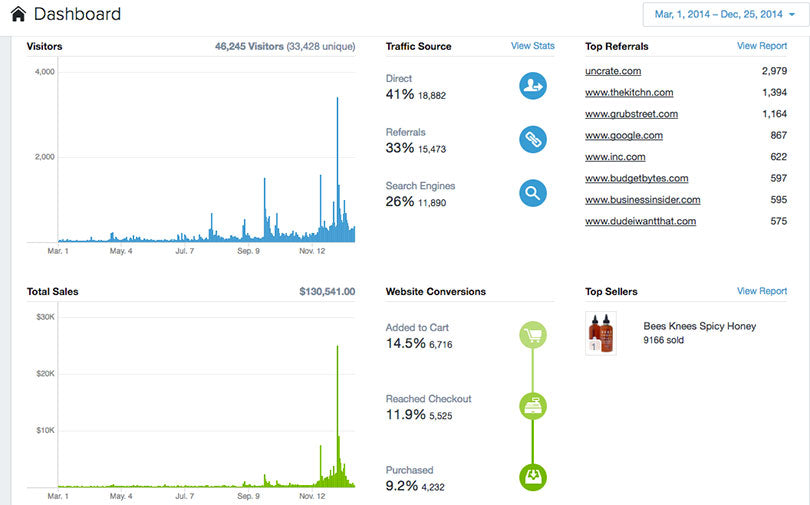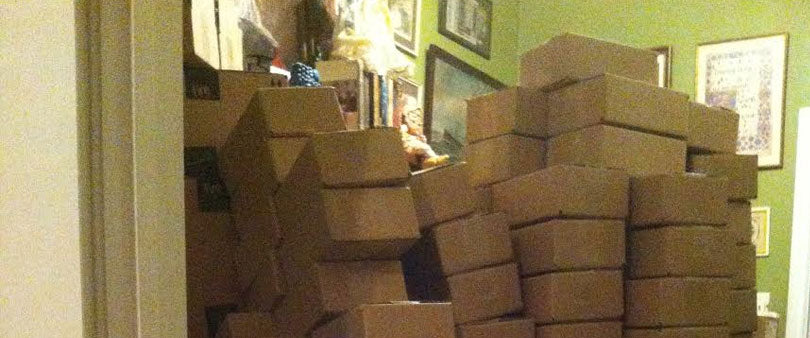MixedMade is the combined efforts of Casey and Morgen, who found that the most interesting things come from mixing the unexpected.
They set out to make the most versatile and delightful hot sauce using just two ingredients: honey and chili peppers.
They’ve quickly grown their small batch honey business into an extremely successful online store that has expanded into retail locations.
I was able to catch up with Morgen, and in this post he shares some information on how they grew so quickly.
Editor's note: Since the time of this interview, MixedMade has rebranded to Bushwick Kitchen. We've kept the interview as-is to provide a snapshot of where they were in 2015.
Describe your business and product.
MixedMade makes delicious products by combining unexpected ingredients that basically throw a party for your taste buds.
Our first product - Bees Knees Spicy Honey - combines raw honey sourced from a small farm in Hudson Valley, with a special blend of chili peppers to create the perfect balance of sweet mellowness & spicy intensity. It's the most versatile hot-sauce ever.
As a business, MixedMade is meant to serve as an example and hopefully an inspiration for how simple it can be to launch your own business.

Free Video Series: Ecommerce Inspiration
Feeling uninspired? Watch some of the world's most successful entrepreneurs share their best advice for new business owners.
Get our Ecommerce Inspiration video series delivered right to your inbox.
Almost there: please enter your email below to gain instant access.
We'll also send you updates on new educational guides and success stories from the Shopify newsletter. We hate SPAM and promise to keep your email address safe.
How did you create, manufacture or source your product? What were some lessons you learned during this process?
Since we had only 30 days to get from idea to shipping product, we had some additional pressures in creating and sourcing our product.
A full day of intensive online and phone research turned up a bunch of leads for our main ingredient, honey. Simultaneously Casey (the mastermind behind our products) was busy in the kitchen, testing dozens of flavor and spice combinations to get the perfect blend.
We really believe in building relationships and thus prefer in person meetings whenever possible, which led to a few days and coffees with beekeepers in the Hudson Valley.
We were fortunate to rely on help from our community and friends in Brooklyn, like how one talented designer came up with our beautiful packaging in just three days, for free!
Make relationships, not transactions
The time we “invested” into in-person meetings and building solid relationships with our suppliers and partners in the first months of business paid off exponentially as these partners all came to our aid, and never let us down, during a December holiday rush that resulted in 2200% growth in sales over previous monthly averages.
Time spent ≠ value added
Instead of perfecting our recipe over months we intensively tested, revised, and refined options until we had something we thought was amazing. We decided to put our product to the real test by selling it to paying customers ASAP, since paying customers are the best feedback we could ever gather.
How did you promote your business initially and where did your first sales come from? Any major media mentions or PR wins since then?
We wanted to offer our Bees Knees for presale as soon as possible, which happened about 3 weeks into our 30-day launch plan.
As spicy honey is a new category, we knew that creating awareness would be key to sales, and thus the importance of press became extremely apparent.
Our first efforts included emailing our personal contact lists and posting to our personal Facebook pages (asking for feedback is much easier than asking for sales) which led to our first $1,000 in sales.
Knowing that press begets press, we made a list of potential press targets and our possible connections to these targets, and then Casey aggressively pursued any and every lead.
What began as some great but modest mentions (from the likes of Huckberry and a few prominent Instagram’ers) snowballed into features on Uncrate and The Kitchn, TV appearances on CNBC and the Today Show and great coverage in the glossy pages of Bon Appetite, Esquire and Vanity Fair!

Don't be afraid to dig into the weeds once in a while. We looked at the profiles of people commenting on friends' Instagram posts of our Bees Knees Spicy Honey.
Whenever one of them was extra interesting (huge following or relevant position) we replied to them or direct messaged them.
For some of the traditional media wins (print) we took the extra step to drop off samples in person and attempt to build a personal relationship.
Press rarely comes easily, even when it snowballs, so be prepared to put in the work
As we’ve written about in the past, you should have a plan, a pitch, and generally attempt to make a journalist or editor’s life easier when you present your product or story to them.
Persistence pays off
Think of your relationship with press as a long term one, geared towards years in the future rather than one story to make or break next quarter’s sales. If your story isn’t relevant for the next issue of ___ magazine, it doesn’t mean your new product launch next year wouldn’t be a perfect fit for them.
Don’t ignore the little guys
As much as we love talking about our coverage in national magazines and TV shows, we’ve gained so much support and so many customers from a number of smaller blogs and publications that we had never even heard of like Budget Bytes. These can be hard to discover, but once you get a few it’s not hard to find other similar outlets that should give you an equally great conversion.
Note: one of the best ways to use Google Analytics is to pay attention to your highest converting traffic sources rather than your highest revenue traffic sources. Try to then find other similar sources and figure out how to get more coverage with them.
How did your sales pick up?
The press that built in the last few months of the year led to 2200% growth for the 30 days leading up to Christmas.
This was a curse and a blessing, as we loved the sales but were honestly unprepared for that kind of boost.
In our first year of operating we had revenues of roughly $170,000 and about $100,000 of that came in the holiday month.

However, getting press coverage is not a predictable growth plan, and we want a predictable growing business.
So we’ve also spent a lot of time focusing on segmentation, which is essentially thinking about your entire customer group in different ways depending on where they fall in the sales lifecycle.
Instead of writing pages on this, I’ll just share that our entire business changed once we discovered the lessons and content of Drew Sanocki, one of the foremost segmentation and e-commerce gurus out there.
In addition, we’re focusing a significant portion of our resources supporting and growing our wholesale accounts (mostly small retail stores) as those accounts have proven to be valuable and often send customers back to our e-commerce store, and vice versa.
How do you handle fulfillment and organize the back-end of your business? Can you share some key lessons and tips on doing this successfully?
We manage all our production and fulfillment manually. When we suddenly had 6,000 bottles to produce, fill, and ship in a week’s time in mid December - we almost went crazy.
However, we had thankfully invested in systems and partners that could support sudden chaos and growth. Our community really stood behind us when things went nuts, and we couldn’t have pulled off that growth without their help. Besides friends and family helping pack boxes in 20 hour shifts, we even had one customer volunteer to help just so he could be part of the ride!

There is a great tool available (in the Shopify App Store or elsewhere) for virtually anything you need to accomplish or automate on the back-end of your business.
Think of these tools and systems like insurance – they are nice to have when things are slow, predictable, and the sun is shining. However, having the good ones in place and properly set up reveal their true value when you get a boost in sales, have major issues with other areas of the business, or need to focus your time elsewhere.
We considered these tools and systems essential and thankfully spent time and a little money setting them up as we depended on them when our business was convulsing.
It is not important which tools or systems you use, but rather that you are constantly evaluating your business and making adjustments to improve its performance and also pave the way for growth.
What software, tools, and resources are crucial to your business?
It goes without saying that Shopify is the base platform we’ve used as our foundation.
I acknowledge this is a Shopify article, but I chose Shopify well before we launched because I have friends who run multi-million dollar businesses off Shopify, and even some of the best in the e-commerce business, like Andrew Youderian use it for his businesses.
I know zero coding and I’m not a good designer but our site looks great and functions flawlessly. Our most essential and favorites that we’ve integrated include:
- Xero for accounting
- ShippingEasy for fulfillment
- Mailchimp for email management
- Yotpo for product reviews
- Pop-Up Window for gathering email subscribers and improving conversion
- Google for Business / Analytics (email and analytics, of course)
- Canva for making things look pretty as a non-designer
What are your top recommendations for new store owners?
Starting a new store can feel overwhelming – what colors to choose, which systems do you need, how many products to launch with, what prices are right – and 100 other daunting decisions.
Fortunately, you can follow a few steps to make your life easier and gain progress quickly.
Besides static resources like articles, there are plenty of forums and options like Clarity where you can connect with an expert for free at a reasonable cost.
For example we get a lot of questions and comments on our blog, and respond to every single one because we love being part of the e-commerce community and believe in helping each other whenever possible!
Simplify and focus
We almost launched with two products, but realized it would be nearly twice as easy to launch with one instead.
You don’t need every bell and whistle on day one. Determine what are the absolute essential components you need to launch, and focus only on them. Once you’re comfortable the essentials are in place begin testing (selling), make adjustments, and focus on the next most important steps.
The wrong action is better than no action
You’re not going to fail from trying something and realizing it is wrong or needs to be adjusted. However, you might fail if you never try anything and haven’t made meaningful progress months down the line.
Don’t go it alone
We live in a world where there is a plethora of easy to find, high quality content on just about anything. If you want to understand SEO, segmentation, transactional emails, or anything else related to your store you’re only a few clicks away on Shopify’s blog or Google.
Want to learn more about Morgen and Casey's journey? Be sure to follow along at the MixedMade blog.

About The Author
Tucker Schreiber is an ecommerce entrepreneur and content crafter at Shopify. He writes to inspire, educate, and inform readers on all things commerce.
Follow @tuckerschreiber

